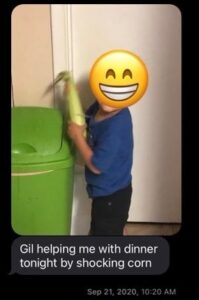As the world shut down in response to the COVID-19 pandemic, countless families were left in crisis. Suddenly, parents were full-time caregivers, employees and teachers; they needed support more than ever. When Gaby Rosario began working as the new Parents as Teachers state leader for Start Early Washington last year, she admired how home visiting programs quickly and effectively adapted to virtual visits to continue meeting the needs of families.

Flexibility is Key
Home visitors strive to build strong relationships with parents and encourage positive parent-child engagement to support healthy child development and future outcomes. One of the most powerful tools they have is connecting with families face to face, but when all in-person services shut down due to the pandemic, physical contact was no longer an option.
“Challenges brought on by the pandemic allowed us to stretch our minds and creatively support home visiting services,” Gaby highlighted. Home visiting programs pivoted to individualized services meeting the unique needs of families from a safe distance. “We shortened check-in periods and checked in more often, utilizing various methods of engagement such as email, text messages and phone calls to support families as they worked through learning and reflection.”
Conducting home visits on a virtual level meant staff had to think outside the box to ensure all the required components for a visit were still in place. Parental engagement unexpectedly increased for many families. “It was deeply meaningful when parents shared videos and pictures of their children thriving with the individualized activities created specifically for them. Gaby shared, “Our relationships with families deepened and it was rewarding to witness the positive parent-child interactions.”

With social distancing precautions in place, home visitors’ roles during visits shifted dramatically. They relied on families to lead parent-child interactions, which brought unexpected benefits as families took on leadership in the learning process. Home visitors leaned into coaching, supporting, answering questions and facilitating rather than leading home visits.
Gaby described, “We saw a new level of enjoyment with families that chose to participate virtually; parents’ confidence in leading individualized activities grew and we saw deeper connections between parents and their children. Parents’ messages of excitement, ‘Look what my child did today!’ were so inspiring.”
Reaching Rural Families
“One of the key things the pandemic taught us was that we could reach families further away through virtual systems.” As an expert in serving families in rural communities, Gaby was determined to partner with her team to harness technology-based services. By offering virtual home visiting services, they managed to overcome the challenges of long-distance travel and access to remote areas in bad weather.
Staff repurposed travel time to spend more time intentionally individualizing services for families. “Without the need to be physically present, home visitors provided more flexibility, accommodating family scheduling constraints or last-minute changes, if necessary,” explained Gaby.
Some families did not have access to technology at all. To meet this challenge, programs developed innovative solutions, including purchasing tablets and providing families with internet and cellphone assistance. Other strategies included scheduling virtual meetings at community agencies or public libraries, where families accessed broadband and technology-based services.
A few families lived in extremely isolated areas. Consequently, home visitors preplanned connections with families when they traveled into town and had access to virtual services. Gaby added, “One family lived deep in the mountains on the outskirts of the small city of Tonasket. When it wasn’t possible to connect in town, staff journeyed into the mountains to drop off activities and make a personal connection, even if that meant they had to share stories from 6 feet apart. We made every effort to ensure families had what they needed during this difficult period of isolation.”
Letting Families Know They’re Heard
Although bilingual resources were available for families, not all programs had home visitors that spoke languages other than English. Fluent in English and Spanish herself, Gaby understood the importance of connecting with families in a language they felt most comfortable. Before the pandemic, programs arranged in-person translation and interpretation or utilized call-in services for interpretation during in-person home visits. However, with social distancing precautions in place, it became necessary to adapt this practice. As a result, programs pivoted to virtual translation and interpretation tools, which took extra planning but were well worth the effort. Staff coordinated within agencies to share translation and interpretation services, and translators provided services over three-way calls or virtual platforms.
Gaby shared, “There was a learning curve as teams and families navigated multiple platforms and new methods of technology. Families tried new things they never thought they would try, and we continued to provide the one-on-one support they needed to feel comfortable.”
The technical support provided by staff did more than help with home visiting services; it offered families a window to the outside world again. Gaby explained, “The assistance we provided for a Spanish-speaking mother living in Brewster gave her confidence to support her three school-age children with their virtual classes. At the time, families did not know what virtual engagement looked like or how to navigate tools like Zoom. Together, we made sure her tablet settings were in Spanish, downloaded useful apps and walked through navigating virtual engagement.”

